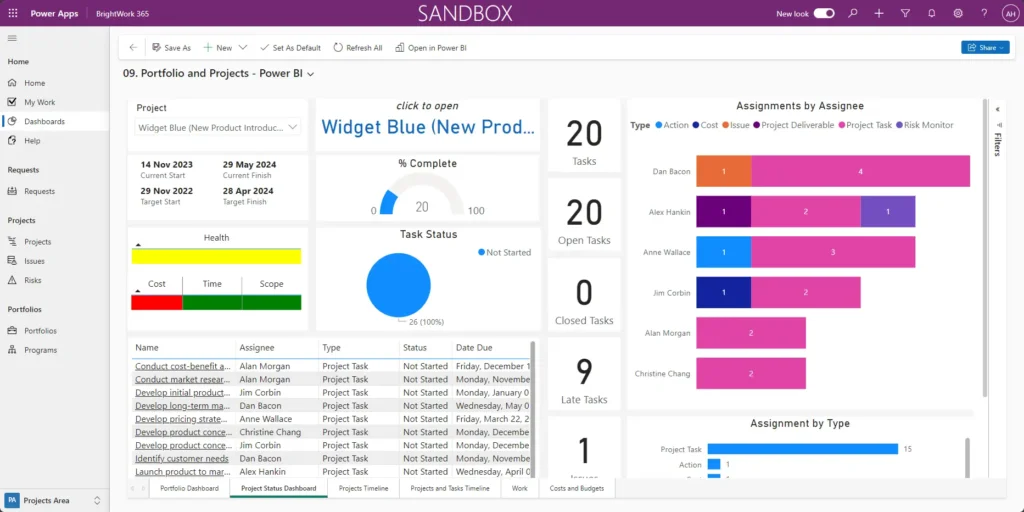One of the most difficult parts of the job for a new project manager is managing the relationships and expectations with senior executives and project sponsors.
This vital relationship should not be overlooked. According to a recent PMI study (PDF), projects that involve sponsors directly tend to face fewer conflicts, operate more smoothly, and achieve better alignment between what they deliver and stakeholder satisfaction.
Overcoming Communication Barriers
Often, poor communication is the root cause of poor sponsorship engagement. For various reasons, project updates are often inaccurate and not provided in a timely manner.
As a result, sponsors and senior executives don’t participate fully in the project. It’s not that they don’t want to be helpful, as they have a vested interest in the successful delivery of the project. But without a clear picture of the project’s status, it is hard to give quality feedback and guidance.
Don’t turn sponsors into roadblocks. With open and accurate communication, you can turn them into enablers who can help get a project back on track when they are needed.
What is a Project Sponsor’s Role?
To properly engage sponsors, you first need to understand their main responsibilities. Project sponsors secure funding, advocate for the project, and make high-level decisions.
They provide strategic direction to align the project with business goals and champion the project across the organization to build support and remove obstacles.
The sponsor has the final decision-making authority on major issues or changes that impact the project’s scope, budget, or timeline.
How to Plan Your Sponsor Engagement Strategy
A proactive approach to engagement begins with a structured plan. Before your first meeting, conduct a thorough stakeholder analysis to grasp the political environment.
A power-interest grid can help you categorize stakeholders, including your sponsor, to tailor your communication style and frequency. This information should be documented in a formal stakeholder register for ongoing reference.
From this analysis, you can develop a tailored stakeholder engagement plan that outlines how you’ll interact with each principal player.
Strong sponsor engagement plans are proactive, not reactive, and set the stage for a successful partnership.
Open Communication
It’s important that the project manager keeps executives and project sponsors up-to-date on the progress of a project, even when it’s all good news. This will help you build a relationship and rapport with the project sponsor.
Having this kind of open communication and trust will make it easier to warn sponsors early about the possibility of trouble as soon as it comes up, even if it hasn’t happened yet.
Communicate Early, Communicate Often
Sponsors dislike bad news, but dislike late bad news even more.
When you are handed a project, you commit to delivering on objectives and parameters. Your job as a great project manager is to steer the project to deliver those goals, always planning and re-planning to meet objectives.
Sometimes, one of those key parameters may fall far outside control (e.g., the project will be delayed by 2 years, require four times the resources, or will finish with half of the expected deliverables).
Such issues must be escalated to the sponsor as soon as they arise. Early warnings are best because if you wait too long, it will be too late to do anything about it.
Active Engagement
Your engagement strategy is put into action through a formal project communication plan.
This plan should detail how you will report progress against major project milestones and to whom.
It also needs to outline the process for escalating issues and the strategies for risk mitigation.
Project Governance

To handle scope adjustments without derailing the project, you must establish a clear change management framework agreed upon with the sponsor. A simple format you can use for regular updates is the S-I-R acronym:
- Status – Referring to the project goals.
- Issues – Problems that need to be sorted.
- Risks – Problems that might happen.
Project sponsors and executives may not focus on every detail, but should be able to drill down into specifics as needed.
This recorded webinar showcases key portfolio reporting capabilities within BrightWork 365.
Common Engagement Challenges and How to Overcome Them
Even with a solid plan, challenges can arise. A major hurdle is managing stakeholder expectations when their views differ from project reality.
Sometimes you may have to deal with an accidental project sponsor. This is someone who inherited the position without full context or commitment. In these situations, securing buy-in requires demonstrating clear value and alignment with their own goals.
Sponsors often have competing priorities, so it is your job to make engagement easy and consistently highlight the project’s strategic importance to maintain their focus.
How Automated Reports Enhance Sponsor Engagement
The easiest way to maintain sponsor engagement is to use a collaborative project management tool, such as the BrightWork 365 collaborative project management solution.
This tool provides automated reports and dashboards that offer instant visibility to sponsors through Project Portfolio Reporting.
Ideally, these project reports can be sent to stakeholders on a regular basis via scheduled email. For example, you might schedule a weekly update to the project sponsor every Friday with the week’s progress.
Keep Sponsors Informed with BrightWork
Effective sponsor engagement transforms project challenges into opportunities. With a strong sponsor relationship, your project stands a better chance of delivering on its goals and gaining organizational support.
With BrightWork 365, it is easy to keep sponsors updated without adding manual effort. Contact us today to see how our solution supports effective sponsor engagement and project delivery.
Editor’s Note: This post was originally published in July 2017 and has been updated for freshness, accuracy, and comprehensiveness.
